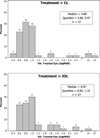A randomized clinical trial comparing contact lens with intraocular lens correction of monocular aphakia during infancy: grating acuity and adverse events at age 1 year
- PMID: 20457949
- PMCID: PMC3512571
- DOI: 10.1001/archophthalmol.2010.101
A randomized clinical trial comparing contact lens with intraocular lens correction of monocular aphakia during infancy: grating acuity and adverse events at age 1 year
Abstract
Objective: To compare the visual outcomes and adverse events of contact lens with primary intraocular lens (IOL) correction of monocular aphakia during infancy.
Methods: In a randomized, multicenter (12 sites) clinical trial, 114 infants with a unilateral congenital cataract were assigned to undergo cataract surgery between 1 to 6 months of age either with or without primary IOL implantation. Contact lenses were used to correct aphakia in patients who did not receive IOLs. Grating visual acuity was tested at 1 year of age by a masked traveling examiner.
Main outcome measure: Grating visual acuity at 1 year of age.
Results: The median logMAR visual acuity was not significantly different between the treated eyes in the 2 groups (contact lens group, 0.80; IOL group, 0.97; P = .19). More patients in the IOL group underwent 1 or more additional intraocular operations than patients in the contact lens group (63% vs 12%; P < .001). Most of these additional operations were performed to clear lens reproliferation and pupillary membranes from the visual axis.
Conclusions: There was no statistically significant difference in grating visual acuity at age 1 year between the IOL and contact lens groups; however, additional intraocular operations were performed more frequently in the IOL group.
Application to clinical practice: Until longer-term follow-up data are available, caution should be exercised when performing IOL implantation in children aged 6 months or younger given the higher incidence of adverse events and the absence of an improved short-term visual outcome compared with contact lens use.
Trial registration: ClinicalTrials.gov NCT00212134.
Figures



Comment in
-
Monocular infantile cataract: treatment is worth the effort.Arch Ophthalmol. 2010 Jul;128(7):931-3. doi: 10.1001/archophthalmol.2010.130. Arch Ophthalmol. 2010. PMID: 20625058 No abstract available.
References
-
- Frey T, Friendly D, Wyatt D. Re-evaluation of monocular cataracts in children. Am J Ophthalmol. 1973 Sep;76(3):381–388. - PubMed
-
- Beller R, Hoyt CS, Marg E, Odom JV. Good visual function after neonatal surgery for congenital monocular cataracts. Am J Ophthalmol. 1981 May;91(5):559–565. - PubMed
-
- Lorenz B, Worle J. Visual results in congenital cataract with the use of contact lenses. Graefes Arch Clin Exp Ophthalmol. 1991;229(2):123–132. - PubMed
-
- Amos CF, Lambert SR, Ward MA. Rigid gas permeable contact lens correction of aphakia following congenital cataract removal during infancy. J Pediatr Ophthalmol Strabismus. 1992 Jul-Aug;29(4):243–245. - PubMed
-
- Neumann D, Weissman BA, Isenberg SJ, Rosenbaum AL, Bateman JB. The effectiveness of daily wear contact lenses for the correction of infantile aphakia. Arch Ophthalmol. 1993 Jul;111(7):927–930. - PubMed

